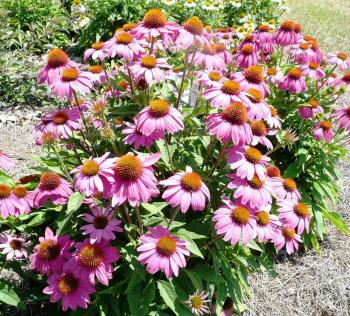
echinacea, or coneflower, perennial of the year
The National Garden Bureau has selected echinacea, commonly known as coneflower, as its 2014 perennial of the year because of the vast assortment of flower colors and shapes available to today’s gardener. It’s also an American staple.
The classic flower shape continues to be a favorite in home and public gardens, so it’s time to highlight the history of the “tried and true” classics as well as some of the newer varieties sure to please any home gardener.
The coneflower is native to central and eastern North America. Related flowers include daisy, sunflower and aster. Besides its native landscape and prairie appeal, the herbal and medicinal use of echinacea has been documented through the years.
Many gardeners may not be aware that echinacea can be grown easily and enjoyed as a garden flower. Today, more and more gardeners are seeking out perennial plants as long-term investments that offer good value at an effective cost.
Perennials are the building blocks of any home garden. Landscape designers widely use perennials in planting beds as a way to provide multi-season color, texture and shape and to reduce garden maintenance. Gardeners perceive perennials in general as a good value because their hardiness and forgiving nature equate to less risk.
Echinacea has been seeing significant growth in breeding activity. It remains a “top five” perennial in terms of retail sales. Poor winter hardiness is a source of frustration with some gardeners. In Louisiana, root rot diseases plague this popular perennial.
Echinacea is attractive to birds, bees and butterflies, making it a great choice for a pollinator-friendly garden. It is generally deer resistant.
Because of their root structure, the plants are drought-tolerant and can withstand heat and wind. Used in garden borders or backgrounds, echinacea adds color and texture for a wildflower or prairie-style garden.
For best visual impact, plant echinacea in masses and deadhead florets to encourage further blooms. Echinacea flowers from late spring through early to mid fall in Louisiana. Its seed heads can be left to dry on the plant to feed wild birds through fall and winter.
Echinacea are generally low maintenance. They should be planted in full sun – or light shade in hotter climates. Dividing every few years will keep them healthy. No additional fertilizing is necessary because heavy fertilization leads to tall, leggy plants that flop over.
Also avoid over-watering because echinacea prefer drier conditions once established.
Popular varieties to try in 2014 include Cheyenne Spirit, White Swan, the PowWow colors, Magnus and the relatively new Sombrero colors.
Cheyenne Spirit is a seed-grown hybrid with excellent overwinter performance on drought-tolerant plants. It is an All-America Selections winner, regarded for its brilliant segregated color range of red, orange, purple, scarlet, cream, yellow and white. It grows 18 to 30 inches tall and 10 to 20 inches wide. This variety has performed very well in LSU AgCenter landscape trials.
White Swan is a white-blooming variety growing 18 to 22 inches tall. Raised from seed, it has a yellow center over dark green, coarse and serrated leaves. It is heat- and drought-tolerant.
PowWow coneflowers are available in white and wild berry. PowWow Wild Berry is an All-America Selections winner. These are from seed and have been great long-term bloomers in the LSU AgCenter trial gardens in Hammond and have been reliably perennial. Both of these colors produce plants 16 to 20 inches tall with a spread of 16 inches.
Magnus, a basally branching, seed-grown variety, grows to 26 to 36 inches tall and produces large 4.5-inch blooms. Petals are held flatter than other varieties in a pink-rose color with orange-brown center. Magnus tolerates heat, drought and wind.
The Sombrero series coneflowers are new from Darwin Perennials and come in several colors. Salsa and hot coral have been impressive in LSU AgCenter trials. These are vegetatively grown. Plants have shorter heights and wider spreads than the others mentioned. The group produces vibrant flower colors.
The National Garden Bureau provided much of the information for this article. The LSU AgCenter has evaluated many coneflowers over the past three to four years, and the ones mentioned here are some of the better performers. You can see more about the programs and plants of the National Garden Bureau at www.ngb.org.
For more information, contact Dr. Chris Robichaux, county agent/area horticulturist, St. Martin/Iberia parishes, at 332-2181 or 369-4440.
- Log in to post comments
